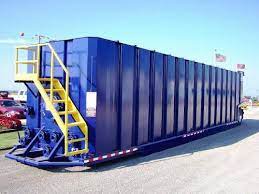1. Mud Storage:
Mud storage is a fundamental function of mud tanks in the oilfield. These tanks are massive containers strategically placed on drilling rigs to store drilling mud, a specialized fluid essential for the drilling process. The mud serves multiple purposes, including cooling the drill bit, carrying drilled cuttings to the surface, and creating a pressure barrier in the wellbore.
The capacity of mud tanks is carefully calculated based on the drilling operation’s requirements. The larger the drilling operation, the more extensive the mud storage needs. This ensures a continuous and efficient drilling process, preventing unnecessary pauses for mud replenishment.
2. Solids Control:
Solids control is a critical aspect of drilling mud management, and mud tanks play a pivotal role in this process. Within the mud tanks, various solids control equipment is employed to separate unwanted solids from the drilling mud. Shale shakers are commonly used to remove larger cuttings, while desanders and desilters target finer particles. Additionally, centrifuges may be utilized for further refinement.
The effective removal of solids enhances the properties of the drilling mud. Cleaner mud improves drilling efficiency, reduces wear on equipment, and minimizes the risk of downhole issues. The solids control section of mud tanks is, therefore, a key component in maintaining a well-functioning drilling operation.
3. Mud Mixing:
Mud tanks are equipped with mixing systems to blend the components of drilling mud thoroughly. The composition of drilling mud is carefully engineered to meet the specific needs of the drilling operation. Components such as clay, polymers, and various chemicals are added to enhance the mud’s lubricating, cooling, and carrying capacities.
The mud mixing process in the tanks ensures a homogenous and well-balanced mud composition. Properly mixed mud contributes to efficient drilling, protects the drill bit from excessive wear, and aids in the removal of cuttings from the wellbore.
4. Transfer of Mud:
Mud tanks are interconnected with a network of pipes and pumps to facilitate the transfer of mud throughout the drilling process. Pumps play a crucial role in moving mud between different tanks and through the solids control equipment. This transfer system allows for the continuous circulation of mud, maintaining the necessary mud properties for optimal drilling performance.
Efficient mud transfer is essential to prevent disruptions in the drilling process. Regular monitoring of pump performance and pipeline integrity ensures a smooth and reliable transfer of mud, minimizing downtime and maximizing drilling efficiency.
5. Containment:
The containment function of mud tanks is integral for environmental and safety considerations. Drilling mud contains various chemicals, and its uncontrolled release could have adverse effects on the environment. Mud tanks are designed with robust structures and sealing mechanisms to prevent leaks and spills.
Environmental regulations require the oil and gas industry to implement stringent measures for containment and spill prevention. Proper design, maintenance, and inspection of mud tanks contribute to compliance with these regulations, protecting both the environment and the personnel working on the drilling rig.
Using Mud Tanks More Effectively:
To enhance the effectiveness of mud tanks in the oilfield, several best practices can be implemented:
a. Regular Maintenance:
Routine inspection and maintenance of mud tanks and associated equipment are essential. This includes checking for structural integrity, inspecting valves and seals, and ensuring that all components are functioning correctly. Regular maintenance prevents equipment failures and prolongs the lifespan of mud tanks.
b. Monitoring:
Implementing a comprehensive monitoring system is crucial for tracking mud properties, tank levels, and equipment performance. Real-time monitoring allows operators to identify potential issues early, enabling proactive intervention to prevent disruptions in the drilling process.
c. Training:
Proper training of personnel working with mud tanks is imperative. Personnel should be well-versed in the importance of maintaining mud properties, recognizing signs of equipment malfunction, and responding to emergencies. Well-trained personnel contribute to a safer and more efficient drilling operation.
d. Environmental Compliance:
Adherence to environmental regulations is paramount. Oilfield operators must stay informed about local and international environmental standards and implement practices that minimize the environmental impact of drilling activities. This includes proper disposal of waste and the prevention of mud spills.
Types of Mud Tanks:
Mud tanks are categorized based on their functions and positions in the drilling process. Each type serves a specific purpose in the overall drilling operation:
a. Suction Tanks:
Suction tanks are positioned to receive drilling mud directly from the wellbore. Their primary function is to collect the initial flow of mud and channel it into the mud circulation system.
b. Intermediate Tanks:
Intermediate tanks receive mud from suction tanks and act as an interim stage in the mud processing cycle. These tanks allow for additional treatment and conditioning before the mud moves to the next stage.
c. Reserve Tanks:
Reserve tanks serve as storage units for excess mud. They act as a backup in case of equipment failure or other issues that may disrupt the continuous circulation of mud. Having reserve tanks ensures the availability of mud for the drilling process.
d. Settling Tanks:
Settling tanks are designed to allow solids to settle out of the mud before it is recirculated. This helps in further removing unwanted particles and ensures that the drilling mud maintains its desired properties.
e. Pit Tanks:
Pit tanks are utilized for the disposal of waste and excess mud. They provide a designated space for the collection of materials that are not part of the circulating mud and need proper disposal.
Conclusion:
In conclusion, mud tanks are integral components of the drilling process in the oilfield. Their diverse functions, from mud storage to solids control and mud mixing, contribute to the efficiency and safety of drilling operations. By following best practices in maintenance, monitoring, training, and environmental compliance, operators can maximize the effectiveness of mud tanks and ensure the success of drilling projects. Understanding the different types of mud tanks and their specific roles allows for the proper configuration of drilling rigs based on operational requirements, ultimately contributing to a more streamlined and productive oilfield environment.

